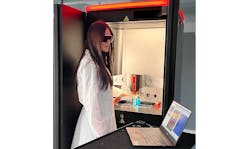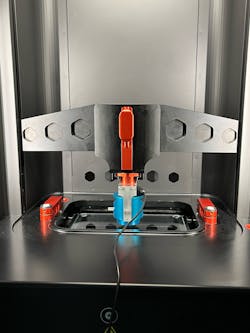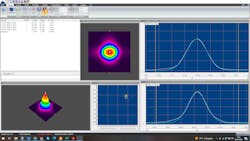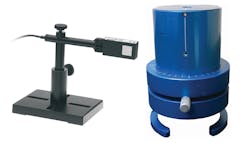Axtra3D was founded in 2021 with the ambitious goal to shake up the additive manufacturing industry. Only one year later, the company introduced its Hybrid PhotoSynthesis (HPS) technology, which is transforming the market. HPS is the first coaxial system to allow the user to print fine features very fast and with superior surface finishing. The innovation is based on a photopolymerization process with two light sources: a digital projector combined with a solid-state laser. Key to the HPS technology is perfect synchronization of the laser beam with the light. With MKS technology, the company achieves the ideal fit and relies on Ophir measurement devices during the whole product cycle.
Overcoming the limitations of photopolymerization
Additive manufacturing offers enormous chances to quickly produce 3D parts. The technology has continually advanced since the first commercial Stereolithography Apparatus (SLA) burst onto the market back in the 1980s. In the meantime, layer-by-layer resin printing is available for everyday home use. But even with industrial high-end SLA solutions, there are still limitations in terms of manufacturing speed and surface quality. In order to overcome the speed limitations, Digital Light Processing (DLP) was developed; it allowed printing of an entire layer at once. A projector flashes images of each layer onto the resin, which cures when exposed to UV light.
Even though the improvements brought by DLP technology are significant, there is still a lot of re-work needed on the finished piece. The printed parts must be washed, and the visible surface structure requires additional treatment. This is where Axtra3D comes in. The company, headquartered in the U.S. with its innovation lab and production facilities located in Italy, was founded around an exciting patent portfolio with the goal to develop groundbreaking additive manufacturing solutions (see Figs. 1 and 2). Paul Spoliansky, founding member of Axtra3D and its chief revenue officer says, “Our technology puts an end to the tradeoffs we’ve seen with other additive technologies. We enable our customers to print true to their CAD files without further re-work needed.”
Combining key technologies in the HPS light engine
The HPS technology recently introduced in the Lumia X1 3D printer includes both a digital light processor that prints the whole layer all at once and a diode solid-state laser that optimizes the structure of each layer in parallel. As with most high-tech solutions, while the result seems easy to understand, the journey there was very complex. Combining the digital light projector and its sophisticated optics with the laser requires perfect harmonization. Both devices need to emit light at the same wavelength: to ensure the high production standards, a maximum deviation of 30 μm is allowed between the two sources. Federico Iacovella, chief product and innovation officer at Axtra3D, explains, “We knew that it would be critical to know the laser parameters and beam shape, so we needed trustworthy measurements.”
Roundness of the beam is key
Ensuring the reproducibility of the additive manufacturing process in the long run is the priority when developing new technologies. Especially when it comes to industrial usage of 3D printers, the customers expect to get identical products with each print job. In order to assure the high quality of the HPS light engine, it is important to transparently check the relevant beam parameters including the beam shape—and not only in the R&D phase and during production, but also when maintaining the printers. With that in mind, Iacovella was looking for an easy-to-use measurement setup that still delivered high-end measurements in each stage of the product life cycle: “We first tried camera-based measurement devices, but we realized that they weren’t suitable for our application in the field. This is why we decided to test slit-based measurement—with great success.”
The Ophir NanoScan beam profiler with its 9 mm aperture offered more flexibility with different beam sizes and is easier to manage. Iacovella continues, “Even if, in the end, what we want to measure is a really small spot size of only 45 μm, we start with a 7 mm beam. With the Ophir NanoScan device, we gain full flexibility due its broad measurement range.” The PC-based instrument analyzes the laser beam spatial irradiance profiles according to the ISO 11146 standard (see Fig. 3). With the accuracy and stability of the beam profile measurement, beam size and beam pointing can be measured with a 3-sigma precision of several hundred nanometers. The HPS light engine needs a laser beam with a circularity of 90%; with the NanoScan measurement solution, Axtra3D is able to accurately measure the diameter and shape of the beam, whether in the clean room or in the customer’s production environment (see Fig. 4).
Managing power and energy
Another core issue with the HPS technology is to always apply a specific laser energy to polymerize the resin. As Axtra3D single-handedly manufactures each diode laser used in the Lumia X1 systems including the diode drivers, there is a strong need to analyze the power of each diode laser separately. Iacovella clarifies, “We use the Ophir PD300-3W sensor to measure the single diode power and thus linearize the response current with the power of each diode. This way, we can ensure that every diode laser will deliver the correct energy needed for each individual 3D printing process. In terms of repeatability, those measurements are critical for both manufacture and maintenance of the Lumia X1 systems.” Measurements of the PD300-3W sensor are displayed with a compact handheld Ophir StarBright power meter, which provides the user with sophisticated power- and energy-logging options, math functions, and a variety of graphical display choices.
New quality level in photopolymerization
Axtra3D’s HPS technology is groundbreaking for the further development of photopolymerization. Not only does the speed of the 3D printing processes surpass SLA printers and match high-speed DLP processes, by using the dual light sources, the technology eliminates the need for post-processing. Which to a great extent directly relates to the measurement technology employed. “Ophir measurement devices are a substantial part of the product innovation, as measuring the laser parameters lays the foundations for the high quality of our 3D-printing technology,” summarizes Iacovella.
ACKNOWLEDGMENT
Ophir is a registered trademark of MKS Instruments.



